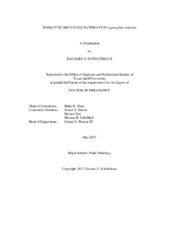| dc.description.abstract | ungi, which dominate many ecosystems as major decomposers and pathogens, generally colonize through the formation of long, tubular cells called hyphae. Understanding hyphal growth has been of interest to cell biologists for a century, and holds the potential to provide insights for many eukaryotic systems. Hyphal growth and shape are intimately connected with membrane trafficking, which is divided into exocytosis (membrane fusion) and endocytosis (membrane fission). Both of these processes are, in turn, essential for hyphal growth. However, endocytosis works to remove membrane, and why it should be important for cell expansion is not known. Here, using genetic manipulation combined with live cell imaging, the role of endocytosis in hyphal growth was scrutinized in the fungus Aspergillus nidulans. First, I examined the localization and function of the canonical endocytic coat protein, clathrin, and discovered that it is involved in budding at the Golgi apparatus, but does not appear to play a significant role in endocytosis. Second, I looked for proteins that may traffic through an endocytic recycling pathway within the hyphal tip, which resulted in identification and characterization of the phospholipid flippases DnfA-D in A. nidulans. These proteins regulate phospholipid asymmetry in the plasma membrane and the endocytic pathway, and are predicted to be involved in linking endocytosis and exocytosis. I discovered that DnfA and DnfB are stratified within the hyphal tip, likely on different vesicles, and require endocytosis for their steady-state localization. Loss of either DnfA or DnfB function has a minor effect on hyphal shape and growth, but loss of both is lethal. Additionally, the phospholipid phosphatidylserine is normally concentrated strictly on the outside of secretory vesicles, but the localization of this phospholipid, as well as several secretory proteins, was disrupted and diffused through the cytoplasm in the absence of DnfA. These results highlight the importance of endocytic recycling in the maintenance of polarized hyphal growth, as well the complexity of the homeostatic mechanisms at work in an actively expanding hyphal cell, which involve proteins and a variety of lipids for normal function. | en |


